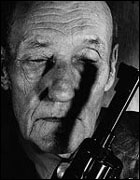 |
|
|
|
When Jack takes his place
on the sofa and dialogue does commence between this strange
ensemble, it is initially remote and dislocated from time,
ostensibly an unconnected barrage of non-sequiters. Dialogue
is displaced, seemingly plucked from the ether or even channelled
through the characters with lines like : “Do not forget
that today is Friday”, and “When will you tell ?”
All of these statements may initially be confusing but take
on a broader meaning in episode two as the psychic resonance
begins to form within the viewers mind. As actions and dialogue
are repeated on screen with reference to lines said three
or four lines back, the work starts to take on a unity of
composition and form a pattern. Some of the sentences uttered
by the individuals refer to questions and statements raised
not only three of four lines back, but to announcements made
in future episodes. It becomes apparent that time itself is
distorted here. What it is also apparent is that Lynch is
making further commentary on the role of the detective here
who must rely on memory to help him solve crimes and mysteries.
Lynch forces the viewer to actively participate in the proceedings
by having them restructure events in their minds : this
may be in contrast to the evidence that is actually depicted
on the screen and calls into question the nature of memory,
reality and truth. What Lynch has done is to employ the techniques
akin to the Beat Generation’s William S. Burroughs in order
to call into question the ways in which audiences interact
with the subject matter dealt to them (13).
By reinterpreting events, Lynch turns the flat space of the
living room into a metaphysical prism of possibilities. This
type of linear conjuring also prolongs the works shelf life
by creating a work of art that is returned to time and time
again.
Although this kaleidoscopic
editing may ensure repeat viewings, to really come to terms
with Lynch’s cut up technique one would need to reassemble
the narrative by transcribing the episodes into a linear fashion
and then look for the clues therein. But Lynch is far too
astute to be caught out by that trick. In fact, if the individual
employs such a manœuvre, it becomes evident that Lynch has
compensated for such a shortfall by having the spoken lines
grouped into ambiguous statements that can be arrived at by
more than one point of entrance. For instance, when Jane says
“There is something I would like to say to you Suzi”,
the answer could be interpreted by any number of Suzie’s responses :
A) “Oh”, B) “I have heard those things said before”,
or C) “When will you tell it ?” The responses
Suzi gives are not qualified by citing Jane’s name in the
equation, and therefore her replies could just as easily be
in response to statements made by Jack at an earlier point
in time, perhaps even in a previous or future episode. This
form of construction could be deemed pretentious and self
indulgent by some quarters, nothing more than the equivalent
of a cinematic crossword puzzles to solve, but this sort of
argument negates Lynch’s power as an artist and denies the
messages and themes that are prevalent throughout his oeuvre.
Far from being wilfully difficult, David Lynch is creating
an art form that touches upon philosophical and metaphysical
concerns.
|